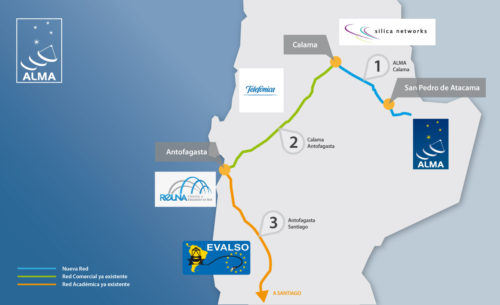A Digital Highway to ALMA
A new connectivity infrastructure that will allow the ALMA (Atacama Large Millimeter / submillimeter Array) observatory to increase its data transmission capacity by more than 25 times begins construction today, thanks to the signing of a contract for optical connectivity between Associated Universities Inc. (AUI), on behalf of ALMA, and two Chilean companies: Silica Networks Chile S.A. and Telefónica Empresas Chile S.A.
"This long-term structural solution not only has the advantage of being able to convey more data, it could also allow us to operate some of the observatory activities from Santiago", says Jorge Ibsen, Head of ALMA Department of Computing.
The new system involves installing approximately 150 kilometers of fiber optic cable between the Radio Astronomy Observatory (34 kilometers from San Pedro de Atacama) and Calama. From there it is connected via existing communication structures to the academic network REUNA point of presence in Antofagasta. From there to ALMA Santiago Offices it will use the infrastructure created in 2010 by EVALSO, a project co-funded by the European Commission which provides connectivity for the ESO observatory at Paranal, among others, and that is operated by REUNA.
This digital highway, to be operational in 2014, will not only transfer the enormous quantity of data that ALMA will produce when fully built, it will also allow for heightened quality in the level of communication between those operating the observatory from its remote and hostile region in the desert of Atacama and those processing the data at ALMA headquarters in Santiago; as well as the scientific community throughout the world. "Taking advantage of Chile’s development in digital connectivity, ALMA is moving towards substantially improving the connection from the remote observatory in the Atacama Desert to the rest of the world" says Jorge Ibsen, adding "this new connection will provide substantial benefits to ALMA operations and enable it to produce even more science."
ALMA, an international partnership of Europe, North America and East Asia in cooperation with the Republic of Chile, is the largest astronomical project in the world and will comprise 66 high-precision antennas located on the Chajnantor plateau, 5000 meters above sea level in northern Chile.


